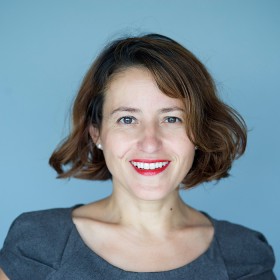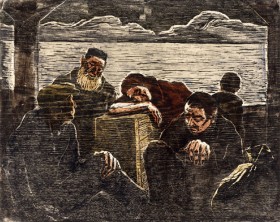The Many Faces of Isaac and Ismael, Part 4
Our special exhibition, “Obedience. An Installation in 15 Rooms by Saskia Boddeke & Peter Greenaway,” has been extended until 15 November 2015. The multimedia art installation takes on the sons’ perspectives of this biblical story, when Abraham intended to sacrifice his son in fulfillment of God’s command. In a film projection at the beginning of the exhibition, visitors are greeted by children, youth and young adults with the words, “I am Isaac” or “I am Ismael,” in a variety of languages.
There’s an interactive component to the exhibition, located in the Eric F. Ross Gallery on the ground floor of the Libeskind Building: A video box where visitors can express these words in their own way and, in so doing, more strongly identify with the child perspective of this story of the attempted sacrifice. We’ve presented a small selection of these video clips on the blog over the last several months.
Lisa Albrecht, continuing her task of compiling the clips, has concluded that Isaac and Ismael not only have many faces, but also many names.
However, not all Museum guests are so ‘obedient’ in fulfilling the video box’s intended purpose: → continue reading
The “Daughters and Sons of Gastarbeiters” (guest workers) are the Academy of the Jewish Museum Berlin’s guest on 14 October 2015, part of the “New German Stories” series. As children, these Berlin authors followed their parents to Germany from their home villages in Anatolia, southern Europe and the Balkans, or they were born into working-class neighborhoods around Germany. Their mothers and fathers were supposed to bolster the German economic recovery as mere “guest workers”. The authors tell their personal stories, look back, follow their parents’ paths and thus add to Germany’s culture of memory. In advance of the event, we’ve asked three questions of Çiçek Bacık, the project’s leader and co-initiator:

Çiçek Bacık © Neda Navaee
Ms. Bacık, how did the “Daughters and Sons of Gastarbeiters” come to be and what was the motivation to tell these personal stories?
Last year, I went to a reading with my friend, the journalist Ferda Ataman. We were sitting in a bar afterwards. “Ferda, we have to start telling our stories and share them with others. We ourselves have to shed light on a dark chapter of our past we’ve successfully repressed,” I said. “Sure, and what’s stopping us?” That was the starting point for “Daughters and Sons of Gastarbeiters”. Our first reading took place in January 2015 at the Wasserturm in Kreuzberg. → continue reading
An Internet Harvest for the Day of the Refugee

“Refugees”, color woodcut by Jakob Steinhardt, 1946, purchased with funds provided by Stiftung DKLB. You can find this and other related objects in our German-language collection database.
This year’s Day of the Refugee takes place today, 2 October 2015 as part of Intercultural Week, with the slogan “Refugees Welcome!” We have taken this as an occasion to go through our own and other websites and blogs, gathering items on this subject. Since we work at a Jewish museum, stories about fleeing are part of our ‘everyday business’: practically all of the family collections given to our museum tell stories of persecution and flight, going beyond mere statistics to depict the fates of individuals. Letters, travel documents, photographs, and personal memorabilia tell of the desperate search for a country to emigrate to, failed or successful emigrations, the often difficult life in a foreign country, the search for relatives, friends, and former neighbors, now scattered across the entire world. We tell these stories in our permanent exhibition and they have also been the subject of various special exhibitions. At the moment, for instance, in our current cabinet exhibition “In a Foreign Country” you can see publications that originated in Jewish Displaced Persons Camps. Jewish men and women waited there for their passage to Palestine or later Israel, to the USA and other countries, where they hoped to start a new life after the Shoah.
In addition to our exhibitions, we also make stories of flight and displacement visible online, for example with a selection of objects: → continue reading

